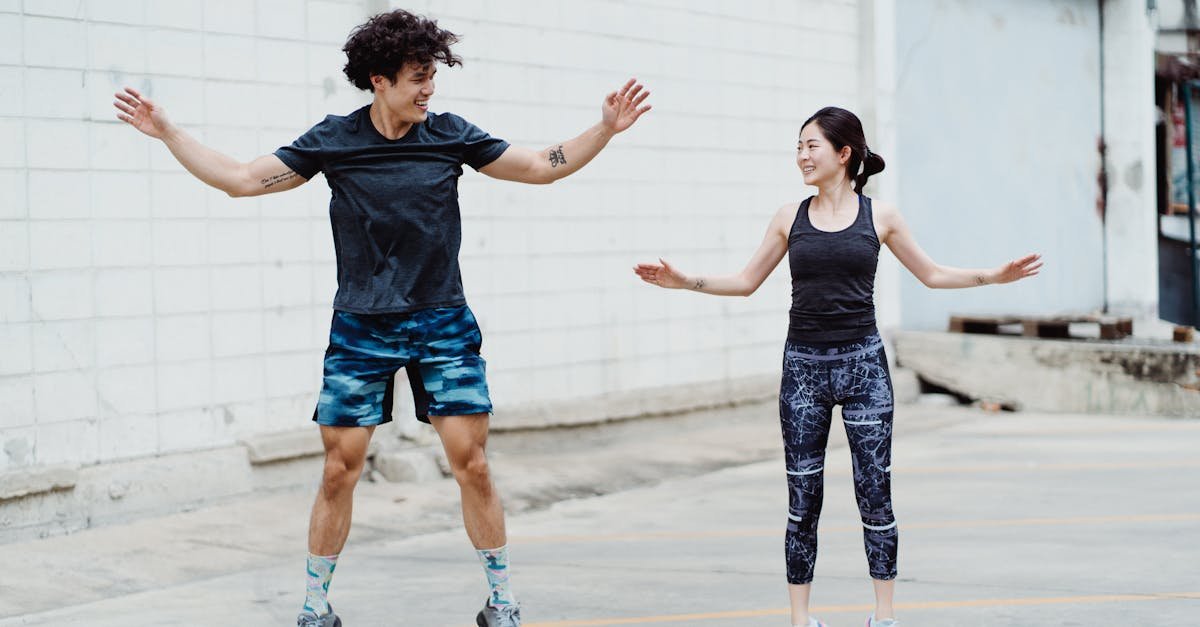Table of Contents
Jump Rope Workout: Fun Cardio Option
Introduction: Why Jump Rope is Your New Best Friend
Rediscovering a Childhood Classic for Serious Fitness
More Than Just Child’s Play: The Power of Skipping
The Awesome Benefits Packed into One Simple Rope
Killer Cardio Conditioning Like No Other
Your Heart Will Thank You
Become a Calorie Torching Machine
Engage Your Entire Body (Yes, Really!)
Boost Agility, Coordination, and Balance
Build Stronger Bones with Every Jump
Fitness That Fits Your Pocket and Your Bag
Ready to Jump In? Getting Started Guide
Choosing Your Weapon: The Perfect Jump Rope
Speed, Weighted, Beaded: What’s the Difference?
Size Matters: Getting the Length Just Right
Mastering the Foundation: The Basic Bounce Step
Level Up Your Skills: Fun Jump Rope Techniques
Mix It Up: The Alternating Foot Step
Pump It Up: Incorporating High Knees
The Ultimate Challenge: Conquering Double Unders
Crafting Your Personal Jump Rope Workout
Don’t Skip the Warm Up: Preparing Your Body
Sample Beginner Jump Rope Routine
Fitting it In: Adding Jumping to Your Existing Plan
Common Pitfalls: Mistakes to Sidestep
The “Too Much, Too Soon” Trap
Watch Your Form: Avoiding Injury
Surface Matters: Protect Your Joints
Conclusion: Jump Start Your Fitness Journey Today!
Frequently Asked Questions (FAQs)
Jump Rope Workout: Fun Cardio Option
Introduction: Why Jump Rope is Your New Best Friend
Remember those carefree days on the playground, skipping rope without a worry in the world? What if I told you that simple childhood toy holds the key to an incredibly effective, fun, and engaging cardio workout? Seriously! Forget slogging away on the treadmill or dreading another elliptical session. Jumping rope is making a massive comeback, and for good reason. It’s time to dust off that rope (or grab a new one!) and discover why this seemingly simple activity might just become your favorite way to get your heart pumping.
Rediscovering a Childhood Classic for Serious Fitness
It’s funny how things come full circle, isn’t it? Many of us probably haven’t picked up a jump rope since elementary school. We associate it with recess, rhymes, and maybe a few tangled messes. But fitness professionals, athletes, and everyday folks are realizing that jumping rope is far from child’s play. It’s a high intensity workout hiding in plain sight, offering a unique blend of cardiovascular challenge, coordination development, and pure, unadulterated fun. Think about boxers – they’ve known the secret for decades, using the jump rope to build incredible footwork, endurance, and agility. It’s time the rest of us caught on!
More Than Just Child’s Play: The Power of Skipping
Let’s get one thing straight: jumping rope, or skipping, is a legitimate powerhouse workout. Don’t let its simplicity fool you. It demands rhythm, timing, coordination, and cardiovascular endurance. Unlike some forms of cardio that can feel monotonous (hello, treadmill zombie!), jumping rope keeps your mind engaged. You have to focus on the rope’s rhythm, your footwork, and maintaining a steady pace. This mental engagement is part of what makes it feel less like a chore and more like a skill you’re mastering. Plus, the feeling of nailing a new trick or lasting longer than before? Pure satisfaction!
The Awesome Benefits Packed into One Simple Rope
Okay, so it’s fun and reminds us of being kids. But what about the actual fitness benefits? Oh, let me tell you, they are plentiful and pretty impressive!
Killer Cardio Conditioning Like No Other
Jumping rope is arguably one of the most efficient ways to improve your cardiovascular fitness. It gets your heart rate soaring in a short amount of time, challenging your heart and lungs to work harder and become more efficient. Regular jump rope sessions can significantly improve your VO2 max – that’s a fancy term for how well your body uses oxygen during exercise. Better VO2 max means better endurance, not just for jumping rope, but for all aspects of your life.
Your Heart Will Thank You
Think of jumping rope as a high intensity interval training (HIIT) session packed into a simple tool. This type of training is fantastic for heart health. It helps lower blood pressure, improve cholesterol levels, and reduce the risk of heart disease. By consistently challenging your cardiovascular system, you’re essentially making your heart stronger and more resilient. It’s like sending your heart to the gym!
Become a Calorie Torching Machine
Looking to shed some pounds or maintain a healthy weight? Jumping rope is your ally. Depending on your intensity and weight, you can burn a significant number of calories in a relatively short period. Some studies suggest that 10 minutes of jumping rope can burn as many calories as 30 minutes of jogging! Because it engages so many muscle groups simultaneously (more on that next), your body needs a lot of energy (calories!) to keep going. It’s an incredibly efficient way to boost your metabolism and burn fat.
Engage Your Entire Body (Yes, Really!)
You might think jumping rope is just a leg workout, but you’d be mistaken! While your calves, quads, and glutes are definitely working hard, so much more is involved. Your core has to stay tight to stabilize your body and maintain proper posture. Your shoulders and arms are engaged as you control the rope’s rotation. Even your back muscles play a role in keeping you upright. It’s a surprisingly comprehensive workout that strengthens and tones muscles from head to toe (well, almost!).
Boost Agility, Coordination, and Balance
Jumping rope requires a constant conversation between your brain, your eyes, your hands, and your feet. You need to time your jumps perfectly with the rope’s swing, land lightly, and stay balanced. This constant neuromuscular challenge significantly improves your coordination, agility (quickness of movement), and balance. These skills are not just useful for sports; they translate directly into everyday life, helping you move more gracefully and reducing your risk of falls, especially as you age.
Build Stronger Bones with Every Jump
Did you know that jumping rope is considered a weight bearing exercise? The impact of jumping, when done correctly, stimulates your bones to become denser and stronger. This is crucial for preventing osteoporosis later in life. It’s a moderate impact activity, generally gentler on the joints than running (especially if you jump on a forgiving surface), but still provides enough stimulus to promote bone health. It’s like giving your skeleton a workout too!
Fitness That Fits Your Pocket and Your Bag
Let’s face it, gym memberships can be expensive, and finding time to get there can be a hassle. A quality jump rope? It costs less than a pizza! And it fits easily into a backpack, suitcase, or even a large purse. You can jump rope virtually anywhere – your living room, backyard, a park, a hotel room. No fancy equipment, no travel time required. It’s the ultimate accessible workout, breaking down barriers of cost and convenience.
Ready to Jump In? Getting Started Guide
Convinced yet? Awesome! Getting started with jump rope is super simple, but a few pointers will help you begin your journey smoothly.
Choosing Your Weapon: The Perfect Jump Rope
Not all jump ropes are created equal. Choosing the right one for you can make a big difference in your experience, especially as a beginner.
Speed, Weighted, Beaded: What’s the Difference?
There are several types of ropes available:
- Basic/Beaded Ropes: These often have plastic segments over the cord. They hold their shape well and provide good auditory feedback (you can hear them hit the floor), making them excellent for beginners learning rhythm.
- Speed Ropes: These have thin vinyl cords or wire cables and spin very quickly thanks to ball bearings in the handles. They are lightweight and ideal for speed work and advanced techniques like double unders, but less forgiving for beginners.
- Weighted Ropes: These ropes have heavier cables or handles. They provide more resistance, engaging your upper body and core more intensely. They’re great for building strength and endurance but require more effort to turn.
For most beginners, a basic PVC rope or a slightly weighted rope (around 1/4 to 1/2 pound) is a great starting point. They offer a good balance of feedback and speed without being overly challenging.
Size Matters: Getting the Length Just Right
Using a rope that’s too long or too short is a recipe for frustration (and tripping!). To find the right length, stand on the middle of the rope with one foot. Pull the handles straight up. For beginners, the handles should reach your armpits or shoulders. As you get more advanced, you might prefer a slightly shorter rope for faster rotations, with handles reaching your chest.
Mastering the Foundation: The Basic Bounce Step
Before you start trying fancy footwork, nail the basic bounce. Here’s how:
- Hold the handles lightly, elbows close to your body, forearms pointing slightly forward.
- Keep your feet close together.
- Initiate the rope swing primarily with your wrists, not your whole arms. Keep your shoulders relaxed.
- Jump only high enough to clear the rope (just an inch or two off the ground). Land softly on the balls of your feet, keeping your knees slightly bent.
- Find a rhythm. Jump, swing, jump, swing. Start slow!
Practice this until it feels smooth and natural. Don’t worry about speed initially; focus on consistency and form.
Level Up Your Skills: Fun Jump Rope Techniques
Once you’re comfortable with the basic bounce, the real fun begins! Learning new steps keeps things interesting and challenges your coordination further.
Mix It Up: The Alternating Foot Step
This feels like jogging in place while jumping rope. Instead of jumping with both feet, you alternate, landing on one foot while the other is slightly lifted, then switching. It looks like this: land right foot, land left foot, land right foot… It’s a great way to transition from the basic bounce and can feel a bit more natural for some.
Pump It Up: Incorporating High Knees
Ready to increase the intensity? Try high knees. As you jump on one foot (like the alternating step), bring the opposite knee up towards your chest. Alternate legs with each jump. This really gets your heart rate up and engages your core and hip flexors more.
The Ultimate Challenge: Conquering Double Unders
Ah, the double under. This is where the rope passes under your feet twice for every single jump. It requires power, speed, and precise timing. Jump slightly higher than usual and flick your wrists much faster. It takes practice (and patience!), but mastering double unders is a huge milestone for any jump roper. Start by trying one double under every 10 or 20 single bounces, then gradually increase the frequency.
Crafting Your Personal Jump Rope Workout
Okay, you’ve got your rope, you’ve got the basics down, maybe even a few tricks. How do you put it all together into a workout?
Don’t Skip the Warm Up: Preparing Your Body
Never jump into intense exercise cold! A good warm up prepares your muscles and joints for the activity, reducing the risk of injury. Spend 5 minutes doing:
- Light cardio (jogging in place, jumping jacks)
- Dynamic stretches (arm circles, leg swings, torso twists)
- Wrist and ankle rotations
Sample Beginner Jump Rope Routine
Here’s a simple interval routine to get you started:
- Warm up: 5 minutes
- Jump Rope Intervals:
- 30 seconds Basic Bounce
- 30 seconds Rest (walk around)
- Repeat 8-10 times
- Cool down: 5 minutes (light stretching, focusing on calves, hamstrings, shoulders)
As you get fitter, you can increase the jump time (e.g., 45 seconds jump, 15 seconds rest) or the total number of rounds. You can also start incorporating different steps like the alternating foot step.
Fitting it In: Adding Jumping to Your Existing Plan
Jump rope doesn’t have to be your *only* workout. It integrates beautifully into other routines:
- Warm up booster: Use 5-10 minutes of jumping rope to supercharge your warm up before lifting weights or doing other sports.
- Cardio finisher: End your strength training session with 10-15 minutes of intense jump rope intervals.
- Active recovery: On rest days, a light 10 minute jump rope session can improve blood flow and aid recovery without overtaxing your body.
- HIIT component: Incorporate jump rope intervals into your existing HIIT circuit (e.g., 1 minute jump rope, 1 minute push ups, 1 minute squats, 1 minute rest, repeat).
Common Pitfalls: Mistakes to Sidestep
Like any exercise, there are common mistakes beginners (and even intermediates) make. Avoiding these will help you progress faster and stay injury free.
The “Too Much, Too Soon” Trap
Jumping rope is surprisingly intense, especially on your calves and shins. It’s easy to get excited and overdo it initially. This can lead to shin splints or other overuse injuries. Start with short sessions (5-10 minutes) and gradually increase the duration and intensity as your body adapts. Listen to your body – rest days are crucial!
Watch Your Form: Avoiding Injury
Poor form not only makes jumping harder but also increases injury risk. Common form errors include:
- Jumping too high: Wastes energy and increases impact. Keep jumps low.
- Swinging with arms/shoulders: Causes fatigue and inefficiency. Use your wrists.
- Landing flat footed or on heels: Jarring for joints. Land softly on the balls of your feet.
- Looking down: Can mess up posture. Keep your gaze forward.
Consider recording yourself or jumping in front of a mirror occasionally to check your form.
Surface Matters: Protect Your Joints
Jumping on hard surfaces like concrete or asphalt puts excessive stress on your joints (ankles, knees, hips). Ideally, jump on a forgiving surface like:
- A wooden floor
- Rubber gym flooring
- An exercise mat or a dedicated jump rope mat
- Firm grass (though watch for unevenness)
Using a mat can also help extend the life of your rope, especially speed ropes with thin cables.
Conclusion: Jump Start Your Fitness Journey Today!
So, are you ready to give jump rope a serious try? It’s far more than just a playground pastime. It’s a portable, affordable, incredibly effective, and genuinely fun way to boost your cardio fitness, burn calories, improve coordination, and build strength. Whether you’re a seasoned athlete looking for a new challenge or a complete beginner searching for an accessible way to get moving, the jump rope offers something for everyone. Stop thinking of cardio as a chore. Grab a rope, find your rhythm, and jump your way to a healthier, happier you. What are you waiting for?
Frequently Asked Questions (FAQs)
1. Is jumping rope better than running for cardio?
Neither is definitively “better”; they offer different benefits. Jumping rope can be more efficient for calorie burning in a shorter time and is often lower impact than running (if done correctly on a good surface). Running might be better for building long distance endurance. Both are excellent forms of cardio, and the best one for you depends on your goals and preferences. Many find jumping rope more engaging and easier to do consistently.
2. How long should a beginner jump rope workout be?
Start small! Aim for 5 to 10 minutes total workout time, including warm up and cool down, 3 times per week. Focus on intervals, like 30 seconds of jumping followed by 30 to 60 seconds of rest. Gradually increase the jump duration or the number of intervals as your fitness improves and your body adapts, especially your lower legs.
3. Will jumping rope help me lose belly fat?
Jumping rope is fantastic for overall calorie burning, which contributes to fat loss all over the body, including the belly area. You can’t “spot reduce” fat from just one area, but combining regular jump rope workouts (which burn significant calories) with a healthy diet is a very effective strategy for reducing overall body fat, which will lead to a flatter stomach.
4. What muscles does jumping rope work?
It’s more of a full body workout than you might think! Primarily, it works your calves, quads, hamstrings, and glutes. However, it also strongly engages your core (abs and lower back) for stability, and your shoulders, forearms, and wrists are involved in turning the rope.
5. Can I jump rope every day?
While you technically *can*, it’s generally not recommended, especially when starting out. Jumping rope is high intensity and repetitive, putting stress on your lower legs. It’s crucial to allow your body time to recover and adapt. Aim for 3-5 sessions per week, incorporating rest days or days with different types of activity (like strength training or stretching) in between. Listen to your body!










